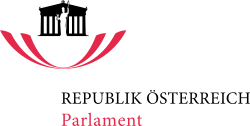Federal Council (Austria)
| Federal Council Bundesrat | |
|---|---|
 | |
| Type | |
| Type |
Upper house of the Austrian Parliament |
| Leadership | |
President of the Federal Council | |
| Structure | |
| Seats | 61 |
Political groups | |
| Elections | |
| Appointment by State diets | |
Last election | No general election |
| Meeting place | |
 | |
|
Parlamentsgebäude Innere Stadt, Vienna Austria | |
| Website | |
| Official Website | |
 |
| This article is part of a series on the politics and government of Austria |
| Constitution |
| Judicial system |
| Foreign relations |
The Federal Council (German: Bundesrat (pronounced [ˈbʊndəsʁaːt]) is the second chamber of the Austrian Parliament, representing the nine States of Austria (Bundesländer) on federal level. As part of a bicameral legislature alongside of the National Council (Nationalrat), it can be compared with an upper house or a senate. In fact, however, it is far less powerful than the National Council: although it has to approve every new law decided for by this "lower" chamber, the latter can—in most cases—overrule the Federal Council's refusal to approve.
The Bundesrat has its seat at the Austrian Parliament Building in Vienna, in a conclave of the former Herrenhaus chamber of the Imperial Council (Reichsrat).
Role
As the Constitution of Austria (B-VG) draws a strict distinction between federal and state legislation, its Article 42 provides the Bundesrat only with the right to veto federal laws passed by the National Council. Moreover in most cases a Federal Council's veto is just suspensive, meaning the National Council can override it, passing the law again by ordinary resolution of at least half of its members. Therefore, the decisions of the Bundesrat can only delay legislation.[1]
In the following cases, though, the Federal Council's approval is mandatory:[1]
- Constitutional laws or regulations limiting the competencies of the federal states
- Laws relating to the rights of the Federal Council itself
- Treaties concerning the jurisdiction of the federal states.
Since its inauguration on 10 November 1920, the deputies of Bundesrat have never achieved the status of a counterbalance in relation to the National Council. Over the decades the role of the Federal Council as a mere adjunct of the Austrian parliament has led to several discussions upon regulatory reforms, towards an actual representation of the states' governments modeled on the German Bundesrat or the complete abolition of the second chamber. So far, the concept has been maintained as a manifestation of Austria's federal system.
The Federal Council and the National Council, if in joint session, form a third parliamentary body: the Federal Assembly that convenes for the oath of office of the President of Austria.
Composition
The 61 members of the Federal Council (Mitglieder des Bundesrats, colloquially called Bundesräte) are elected according to proportional representation by each of the Austrian states' legislatures (Landtage) for 4- to 6-year terms. The composition of the Bundesrat therefore changes after every state election and the distribution of seats in the Austrian Landtage.[2] The second largest faction of the particular Landtag has the right to designate at least one deputy. The number of representatives delegated by each Bundesland ranges between three and twelve, depending on its population as ascertained by a regular census; it is fixed per presidential decree.
Though the Federal Council has no strong party discipline, the deputies may ally along party lines and form parliamentary groups, which have to meet a quorum of five seats, if not admitted by particular resolution.[3] Currently the MPs of the Austrian People's Party (ÖVP), the Social Democratic Party of Austria (SPÖ), the Freedom Party of Austria (FPÖ) and the Greens form political groups in the Bundesrat:
| MPs | ÖVP | SPÖ | FPÖ | Greens | Non-attached | |
|---|---|---|---|---|---|---|
| Burgenland | 3 | 1 | 2 | – | – | - |
| Carinthia | 4 | 1 | 2 | 1 | – | - |
| Lower Austria | 12 | 7 | 3 | 1 | - | 1[lower-alpha 1] |
| Salzburg | 4 | 1 | 1 | - | 1 | 1[lower-alpha 2] |
| Styria | 9 | 3 | 3 | 3 | – | - |
| Tyrol | 5 | 3 | 1 | – | 1 | - |
| Upper Austria | 10 | 4 | 2 | 3 | 1 | - |
| Vienna | 11 | - | 6 | 4 | 1 | - |
| Vorarlberg | 3 | 2 | – | 1 | – | - |
| Overall | 61 | 22 | 20 | 13 | 4 | 2 |
- ↑ Team Stronach
- ↑ formerly Freedom Party of Austria, now Free Party Salzburg
The President of the Federal Council is nominated by the largest party of each state in half-yearly intervals.
Presidency
See also
Sources
- 1 2 "The Responsibilities of the Federal Council – The Federal Council's Right of Objection". Website of the Austrian Parliament. Retrieved 2010-10-04.
- ↑ For the current composition see: "Mitglieder des Bundesrates, die derzeit ein Mandat innehaben" (in German). Website of the Austrian Parliament. Retrieved 2010-10-04.
- ↑ "The Members of the Federal Council – Parliamentary Groups". Website of the Austrian Parliament. Retrieved 2010-10-04.